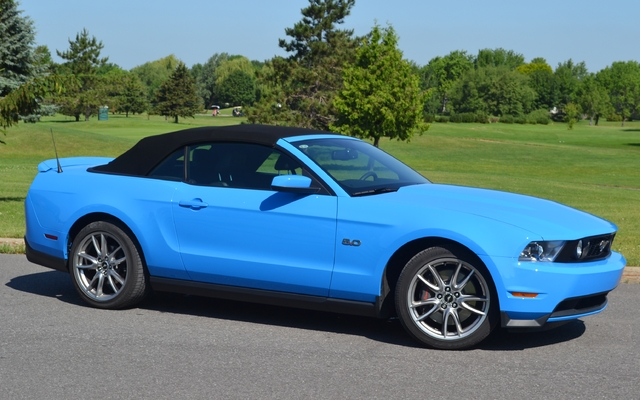2011 Ford Mustang GT: May it never disappear

| Strong points |
|
|---|---|
| Weak points |
|
Most of us dream of buying a sports car one day. Maybe it’ll be a convertible or offer some other feature that is more sexy than it is practical. For a lot of people, this dream is the Ford Mustang, an icon that goes back 45 years and seduces buyers with its irresistible price/performance ratio. While a Porsche is permanently out of reach for most of us, the Mustang is accessible. And that’s exactly why people still love it after all these years.
Although GM and Chrysler threw in the towel a few years back and pulled their muscle cars off the market, they’ve both recently returned to the segment trying to replicate the Mustang’s success. Ford is the only automaker to have stood its ground over the years, not only keeping the Mustang on offer, but updating it periodically to keep buyers engaged. The secret behind their success is quite simple: offer a wide range of trim levels (some more affordable and others more powerful), while stirring up interest with more exclusive versions, like the recent 2012 Boss 302. Whenever the model seems headed for trouble, Ford has managed to put it back in the limelight. In fact, that’s exactly what they achieved with the 2011 overhaul.
A 5.0-litre GT
The 2011 changes to the Mustang mostly affected the drivetrains. In introducing a new 5.0-lite V8, Ford revived an old moniker that defined many a Mustang over the years. Thus, the "Mustang 5.0" was back! This new V8 is a lot more high-tech and not only makes the Mustang GT more competitive, it also allows Ford to revive the past. There’s also a big 5.0 insignia on the side for added emphasis.
With 32 valves, this V8 also equips the F-150 trucks. The figures say it all, as it produces 412 horsepower at a maximum of 7,000 rpm and 390 lbs.-ft. of torque. This is a big jump in power compared to the previous 315-hp V8. Some people may snub this increase, saying it’s not very green, but this new Mustang GT is actually more fuel efficient than its predecessor (thanks to the Ti-VCT independent variable distribution technology and lighter materials used in the engine design). Who said that fuel efficient cars had to be boring?
A Mustang for the People: the V6
Of course, the 2011 Mustang comes in all its different variations, including the coupe and cabriolet. While the Mustang GT and its new engine are obviously garnering a lot of attention, it’s the V6 versions that are responsible for a lot of the sales – and this is to be expected more than ever now that the V6 is more powerful. With 3.7 litres of displacement, this engine produces 305 horsepower and 280 lbs-ft of torque. A 350-hp sports coupe for $24,549? Believe it, baby! Add to that an average fuel consumption of 6.4 L/100 km on the highway (with an egg under your right foot, mind you) and you’ve got one heck of a tempting offer!
Sweet style
Despite all the changes, this year’s Mustang sports the same style as the 2010 model. The front has been made even nicer, with a new plunging hood and classic Mustang grille. This tiger looks ready to pounce at any time. New wheels take it up a notch and you’ve got to love the vibrant colour palette for the body. The rear has been easily recognizable for the past two years, thanks to the angled tail lights that wrap around the sides. Although we’re still getting used to the Mustang’s newish looks, Ford could have emphasized the mechanical upgrades with some more striking aesthetic tweaks.
The same can be said for the vehicle interior, where little has changed since last year. Finish has been steadily improving since the past generations, but it’s still pretty austere. In fact, attention-to-detail seems to be lacking inside the Mustang. Aside from that, the instrumentation has changed slightly to match the new engines. There’s a noticeable improvement in soundproofing, especially in the convertible. Downsides include no telescopic steering column, and yes – still – no Sport mode or manual controls on the steering wheel on automatic vehicles. I’m not a fan of manumatic mode, but on the Mustang it could be a good thing.
Improved performance
With increased power, the Mustang V6 is more tantalizing than ever. Its 305 horses deliver top performances, while the engineers managed to infuse a deep and rich sound into this engine. And there’s no need to worry about finding yourself in a more powerful car with poor suspension and steering. The engineers completely revamped the suspension and made the structure more rigid. The result is a well-balanced Mustang V6 that can skilfully handle all its power. However, its rigid rear axle makes it a little more sensitive to bumps and proves to be a disadvantage on corners. You get the feeling that the car is going to come right off the road.
The Mustang V8’s performances are superb. The engine power and torque are outstanding, and the manual transmission does a great job maximizing the available power. Few vehicles out there will give you chills the way this one does when you step on the accelerator. The new V8 also features a new suspension, which improves its handling. The brakes still have bite, but you’re better off with the Performance Package that includes Brembo brakes.
Everytime I get behind the wheel of a Mustang, I rediscover the pleasure of driving, as well as the pleasure of mechanics over gadgets and other driver assist systems that too many modern vehicles rely on. May this car never disappear, as it would be sadly missed.











